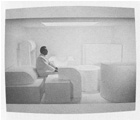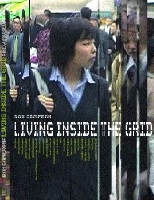 |
 |
 |
Part of
the role of being a curator at the New Museum of Contemporary
Art is to stay aware of what is happening in all areas of contemporary
culture. In this section of the web site, the New Museum curatorial
staff shares some of their favorite gallery exhibitions, films,
book, plays and more! This section is frequently updated, so
check back regularly.
|
 |
 |
 |
 |
MAIN SPACE = PROJECT SPACES
Artists Space
Through May 3
Artists Space has turned its main gallery into nine spaces,
each holding a different artist's work. From Jay Heike's rock
star video installation titled Kill Yr. Idols to Sheila
Pepe's shoestring and rubber band sculpture After the Williamsburg
Bridge, this show includes a wide spectrum of artists
and materials alike.
Rob Fischer combined and reconfigured objects and structures
to create an ambiguous environment of artifacts. He has in
fact transplanted the remains of a past installation piece
into Artists Space. The viewer is immediately confronted with
the bulky skeleton of a dumpster Fischer fashioned out of
metal and glass panels. Piled high with evidence from his
past art piece, the dumpster entices the viewer to investigate
the remnants. Also sharing the space is the wooden floor of
a hallway, complete with thin, white walls that intersect
with a ceiling. Hanging in the middle of this haphazard and
misplaced space, a single, bare light bulb gives off an inviting
and peculiar glow. Fischer creates an engaging situation that
provokes the viewer to speculate about the work's previous
incarnation.
Julianne Swartz's stimulating and humorous site specific installation,
Line Drawing, leads the viewer's eye through a network
of "peep holes" in an otherwise bare room. Each
peep hole reveals a blue, vinyl line stretched around a hidden
room. Upon entering the space, you see a projection of the
blue line reflected out of a hole and onto a piece of plexiglass
that appears to be in motion. She cleverly uses light, mirrors,
the white walls of the project space, and the curiosity of
the viewer to generate her "drawing."
Other artists in this exhibition include Wade Guyton, Sebastian
Romo, Jonathan Calm, Lucas Ajemian, and Tsuyoshi Ozawa.
-KMM
|
 |
 |
 |
Pierre Huyghe: The Hugo Boss Prize
Guggenheim Museum
through May 4
In Pierre Huyghe's mind, the ideal audience for his exhibition
would be a colony of penguins. Indeed, this is an apt metaphor
for communities with systems of communication beyond human
linguistic knowledge, not to mention being a humorous representation
of the masses. Sitting before Huyghe's sculpture, which is
presented as one out of two acts in the exhibition, the audience
is swallowed up by the dark and left as silent, anonymous
silhouettes: propped in various lazy poses, lounging on the
carpet like it's a Sunday afternoon. Yet, as much as the piece
whets the audience's theatrical appetite, the thick, pervasive
fog settles on the stage only to alert us to the absence there,
to the lack of spectacle for our hungry eyes.
The second installment incorporates sound, animation, video,
and sculpture to create a film without narrative or any allusion
to specific time. Using modernist architecture as its historical
point of departure, the exquisitely dark film presents us
with two 1970s-era French government housing projects, now
standing as reminders of the broken promise of utopia, the
failure of city planning, and various strategies of exclusion.
The trees, sans-foliage, leave us searching for seams between
fiction and reality. The buildings seem demonic yet impotent
as the light in their windows flash on and off in accordance
with a pulsating rhythm. The rhythm culminates to a desperate
pace, like a fireworks display that is undecidedly tragic
or celebratory; a collective voice in a forest, not entirely
unheard but sometimes ignored.
-KDJ
|
 |
 |
 |
 |
You Are Here
Diesel Denim Gallery
through June 1
What is the difference between a Chelsea gallery and a Soho
boutique? Both spaces use white walls to transform former
warehouses and sweatshops into temples dedicated to aesthetics
and commerce. Shoppers browse beautifully displayed merchandise
under the careful scrutiny of hipper-than-thou sales attendants.
You Are Here, a site-specific work in Diesel's retail
boutique-cum-gallery space created by the collective Fictive,
skillfully exploits these similarities while calling attention
to the relationships between galleries and boutiques, art
and fashion, desire and consumption. As in earlier projects
such as Fictive Advertising, Fictive Porn, and Fictive
Boutique, the loose collaborative of artists, designers,
and architects manipulates retail strategies for its own subversive
purposes.
Founded by multi-media artist Paul Clay, Fictive uses many
of the same elements employed by Diesel's own advertising:
pie charts, graphs, and glossy oversized photographs. Perhaps
most importantly, You Are Here also employs a similar
sense of irony and distrust of advertising. Diesel's recent
web campaign announced that in the last month the total amount
received in tips by waitresses wearing Diesel jeans has tripled;
You Are Here provides viewer/shoppers with other facts
and figures: 30% of the store's 2,800 square feet is dedicated
to displaying clothes and the average customer spends 15 minutes
in the store. Another graphic shows that you are located at
the convergence point of retail history, retail inventions,
and the Diesel Denim Gallery.
Text on large photomontages remind you that "shopping
is a disorienting experience," but you are made aware
of your surroundings in a variety of ways. Soho emerges through
satellite photos, small images of local architectural details,
and a pie chart explaining the neighborhood's health profile.
The gallery/boutique itself is recreated in both a small-scale
computer model as well as a to-scale mirror version of one
side of the gallery which forces viewers to squeeze through
an uncomfortably tight opening to continue looking at expensive
vests, jeans, t-shirts, shoes, and multi-lingual text panels
suspended from clothes hangers. These textual "products,"
with excepts from the Harvard Design School Guide to Shopping
about retail architecture and the "Gruen transfer,"
the idea that labyrinthine layouts cause goal-oriented shoppers
to wander (and buy) aimlessly, interrupt our passive gaze
and call attention to the global nature of Soho as a tourist
shopping destination as well as to the globalization of product
production and consumption.
As Fictive suggests, "Perhaps the beginning of the twenty-first
century will be remembered as the point when the urban could
no longer be understood without shopping." In Soho, you
are here already.
-EB
|
 |
 |
 |
Dario Robleto: Say Goodbye to Substance
Whitney Museum of American Art at Altria
through July 3, 2003
Dario Robleto acts as cultural archeologist, scientist, and
DJ in this fetish-driven one-man show. Hailing from Austin,
Texas, Robleto has established himself as a strong and vibrant
presence in the art world. He is most known for his obsessive
use of vinyl in his art works; melted, powdered, shattered,
and personally pressed vinyl records which continue to appear
in his works.
In Say Goodbye to Substance, Robleto filled the gallery
with an eclectic, yet forceful collection of conceptual and
evocative "contemporary artifacts" and scientific
samples. A majority of the space is given over to a 10-part
mixed media sculpture, Popular Hymns Will Sustain Us All
(End it All). This dynamic sculpture involves 10 sections
separated by Plexiglas cases, each containing narrative assemblages
including transformed records, dead butterflies, and bone
remnants. Individually, each case invites the viewer to observe
the combination of designated specimen. As a whole, the sculpture
reveals a philosophical approach to Robleto's own deconstruction,
interpretation, and discourse of humanity and social culture.
Also included in this exhibition are several digital prints
of space-age sprouting plants, potted in ceramic dishes, one
of which says, "I Won't Let You Say Goodbye This Time."
Sitting preciously on a white pedestal, a glass encased, red
velvet-laden set of drumsticks made out of meteorite are dedicated
to Keith Moon, the infamous rock and roll drummer for The
Who. The viewer is witness to a merging of disciplines, where
digital mingles with the precedent and music is the underlying
narrative.
Uniting scientific evidence with pop culture, Robleto acts
as DJ and succeeds in interweaving music, social history,
and science in a conceptually intricate display.
-KMM
|
 |
 |
 |
 |
|
 |
 |
 |
|
 |
 |
|
|
 |
 |
 |
 |
 |

Living Inside the Grid
February 28, 2003 - June 15, 2003
First, second and mezzanine level galleries
Living Inside the Grid explores how contemporary artists around the
world are redefining the grid, one of the most significant motifs of 20th century
art, in response to major cultural shifts sparked by the growing confluence
of art, new media, architecture, and urbanism. ////
Photo Credit
Top: ABSALON, Propositions d'Habitation (1991), Color video 3:30 minutes,
Courtesy Galerie Chantal Crousel, Paris
|
 |
 |
 |
 |
 |
MUSEUM HOURS
Tuesday - Sunday: noon - 6 pm.
Thursday: noon - 8 pm.
Closed Monday
STORE HOURS
Monday-Sunday: 12pm-6:30pm
Thursday: 12pm-8pm LOCATION
583 Broadway
(between Houston and
Prince Streets in SoHo)
New York, NY 10012
|
 |
 |
 |
 |
 |
Become a member of the New Museum. |
 |
 |
 |
 |
 |
>
Living Inside the Grid
Softcover: 160 pages
$30.00////
|
 |
 |
|
